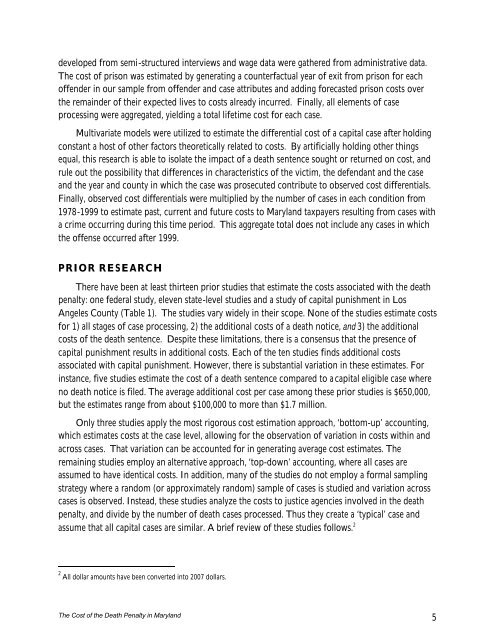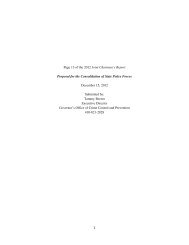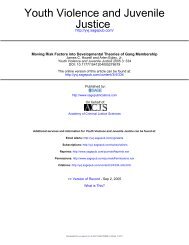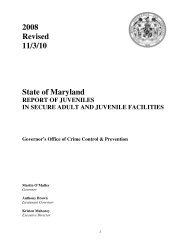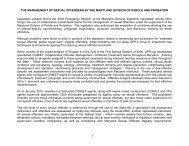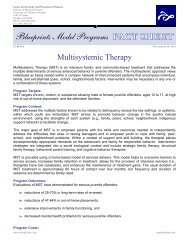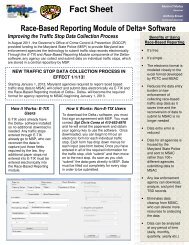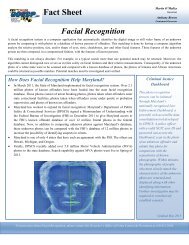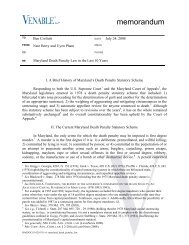The Cost of the Death Penalty in Maryland - Urban Institute
The Cost of the Death Penalty in Maryland - Urban Institute
The Cost of the Death Penalty in Maryland - Urban Institute
Create successful ePaper yourself
Turn your PDF publications into a flip-book with our unique Google optimized e-Paper software.
developed from semi-structured <strong>in</strong>terviews and wage data were ga<strong>the</strong>red from adm<strong>in</strong>istrative data.<br />
<strong>The</strong> cost <strong>of</strong> prison was estimated by generat<strong>in</strong>g a counterfactual year <strong>of</strong> exit from prison for each<br />
<strong>of</strong>fender <strong>in</strong> our sample from <strong>of</strong>fender and case attributes and add<strong>in</strong>g forecasted prison costs over<br />
<strong>the</strong> rema<strong>in</strong>der <strong>of</strong> <strong>the</strong>ir expected lives to costs already <strong>in</strong>curred. F<strong>in</strong>ally, all elements <strong>of</strong> case<br />
process<strong>in</strong>g were aggregated, yield<strong>in</strong>g a total lifetime cost for each case.<br />
Multivariate models were utilized to estimate <strong>the</strong> differential cost <strong>of</strong> a capital case after hold<strong>in</strong>g<br />
constant a host <strong>of</strong> o<strong>the</strong>r factors <strong>the</strong>oretically related to costs. By artificially hold<strong>in</strong>g o<strong>the</strong>r th<strong>in</strong>gs<br />
equal, this research is able to isolate <strong>the</strong> impact <strong>of</strong> a death sentence sought or returned on cost, and<br />
rule out <strong>the</strong> possibility that differences <strong>in</strong> characteristics <strong>of</strong> <strong>the</strong> victim, <strong>the</strong> defendant and <strong>the</strong> case<br />
and <strong>the</strong> year and county <strong>in</strong> which <strong>the</strong> case was prosecuted contribute to observed cost differentials.<br />
F<strong>in</strong>ally, observed cost differentials were multiplied by <strong>the</strong> number <strong>of</strong> cases <strong>in</strong> each condition from<br />
1978-1999 to estimate past, current and future costs to <strong>Maryland</strong> taxpayers result<strong>in</strong>g from cases with<br />
a crime occurr<strong>in</strong>g dur<strong>in</strong>g this time period. This aggregate total does not <strong>in</strong>clude any cases <strong>in</strong> which<br />
<strong>the</strong> <strong>of</strong>fense occurred after 1999.<br />
PRIOR RESEARCH<br />
<strong>The</strong>re have been at least thirteen prior studies that estimate <strong>the</strong> costs associated with <strong>the</strong> death<br />
penalty: one federal study, eleven state-level studies and a study <strong>of</strong> capital punishment <strong>in</strong> Los<br />
Angeles County (Table 1). <strong>The</strong> studies vary widely <strong>in</strong> <strong>the</strong>ir scope. None <strong>of</strong> <strong>the</strong> studies estimate costs<br />
for 1) all stages <strong>of</strong> case process<strong>in</strong>g, 2) <strong>the</strong> additional costs <strong>of</strong> a death notice, and 3) <strong>the</strong> additional<br />
costs <strong>of</strong> <strong>the</strong> death sentence. Despite <strong>the</strong>se limitations, <strong>the</strong>re is a consensus that <strong>the</strong> presence <strong>of</strong><br />
capital punishment results <strong>in</strong> additional costs. Each <strong>of</strong> <strong>the</strong> ten studies f<strong>in</strong>ds additional costs<br />
associated with capital punishment. However, <strong>the</strong>re is substantial variation <strong>in</strong> <strong>the</strong>se estimates. For<br />
<strong>in</strong>stance, five studies estimate <strong>the</strong> cost <strong>of</strong> a death sentence compared to a capital eligible case where<br />
no death notice is filed. <strong>The</strong> average additional cost per case among <strong>the</strong>se prior studies is $650,000,<br />
but <strong>the</strong> estimates range from about $100,000 to more than $1.7 million.<br />
Only three studies apply <strong>the</strong> most rigorous cost estimation approach, ‘bottom-up’ account<strong>in</strong>g,<br />
which estimates costs at <strong>the</strong> case level, allow<strong>in</strong>g for <strong>the</strong> observation <strong>of</strong> variation <strong>in</strong> costs with<strong>in</strong> and<br />
across cases. That variation can be accounted for <strong>in</strong> generat<strong>in</strong>g average cost estimates. <strong>The</strong><br />
rema<strong>in</strong><strong>in</strong>g studies employ an alternative approach, ‘top-down’ account<strong>in</strong>g, where all cases are<br />
assumed to have identical costs. In addition, many <strong>of</strong> <strong>the</strong> studies do not employ a formal sampl<strong>in</strong>g<br />
strategy where a random (or approximately random) sample <strong>of</strong> cases is studied and variation across<br />
cases is observed. Instead, <strong>the</strong>se studies analyze <strong>the</strong> costs to justice agencies <strong>in</strong>volved <strong>in</strong> <strong>the</strong> death<br />
penalty, and divide by <strong>the</strong> number <strong>of</strong> death cases processed. Thus <strong>the</strong>y create a ‘typical’ case and<br />
assume that all capital cases are similar. A brief review <strong>of</strong> <strong>the</strong>se studies follows. 2<br />
2 All dollar amounts have been converted <strong>in</strong>to 2007 dollars.<br />
<strong>The</strong> <strong>Cost</strong> <strong>of</strong> <strong>the</strong> <strong>Death</strong> <strong>Penalty</strong> <strong>in</strong> <strong>Maryland</strong><br />
5


